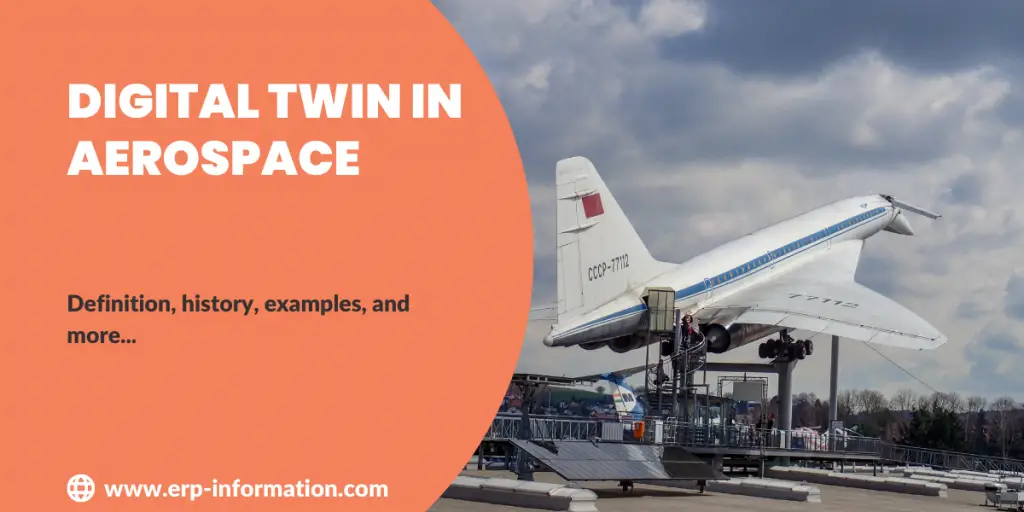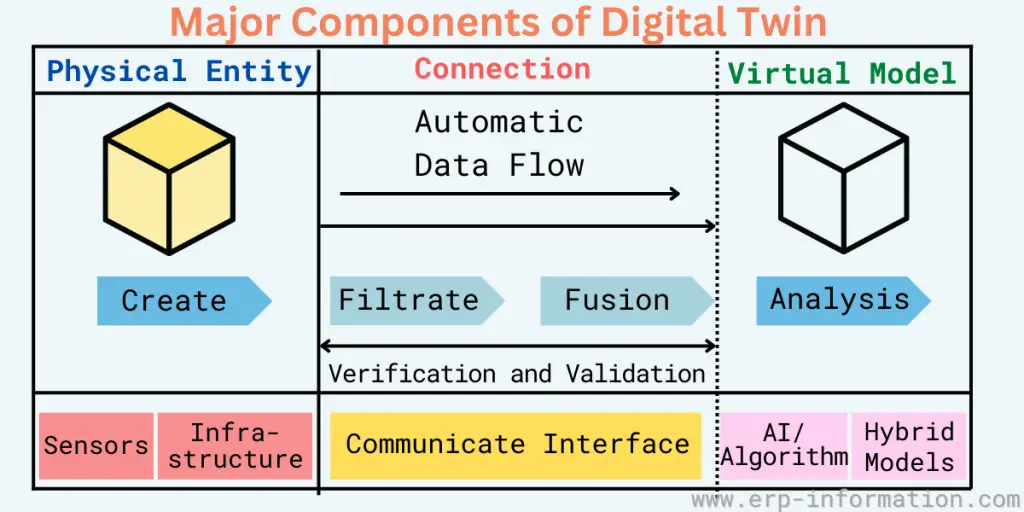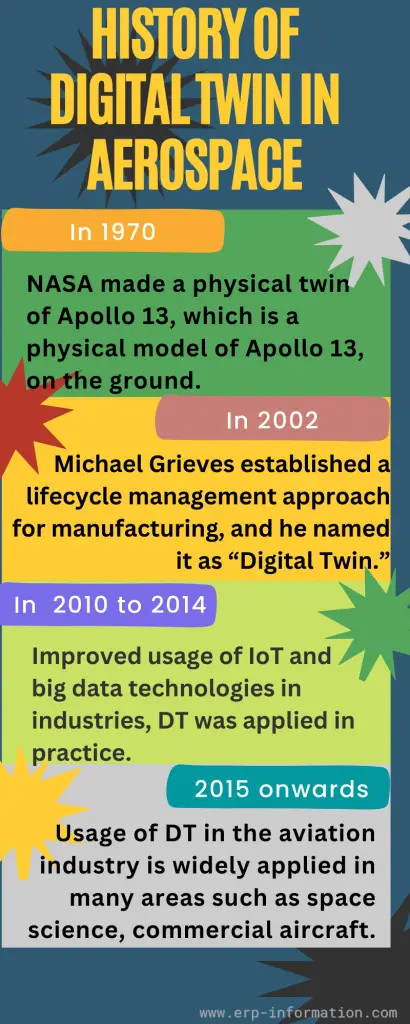Digital twins are revolutionizing the aerospace industry, providing unprecedented efficiency, accuracy, and insight into aerospace assets. Under their ability to track assets in real-time, digital twins enable aerospace companies to gain better control over their operations and maximize efficiency.
Additionally, digital twins provide invaluable insights into maintenance cycles and reliability, allowing companies to deliver better customer experiences at reduced costs.
As more companies recognize the value of digital twins for their operations, it will become ever more important for businesses to understand how best to implement and manage these technologies.
In this post, we will discuss the digital twin in aerospace industry in detail, including its history and benefits.
Definition of Digital Twin (DT)
The digital twin is a digital replica of physical products, processes, and systems that can monitor and analyze real-time performance.
Digital twins are created by collecting and analyzing data from multiple sources, including sensors, actuators, and other devices attached to the monitored asset.
The data is then used to create a virtual model or “twin” of the asset, which can provide insight into its performance and behavior.
What is digital twin in aerospace?
Digital twin technology is an important part of the aerospace industry, allowing companies to gain real-time insights into their assets and operations. Digital twins in aerospace enable tracking performance, maintenance cycles, and other critical aspects of aircraft operation.
By providing accurate information about the physical asset, digital twins allow aerospace companies to make data-driven decisions faster and more precisely.
With this capability, digital twins offer significant advantages in terms of cost reduction, safety enhancement, and performance optimization for aerospace operations.
Digital twin in aerospace industry
Boeing CEO Dennis Muilenburg said the use of digital twins in Boeing had enhanced the quality of systems and parts used in aircraft production by 40%.
Now a trend has been created in aerospace and defense applications, that is, the use of digital twins during the development phase and the system’s lifetime.
Aerospace companies use digital twins to enhance the engineering of new parts by replicating their accomplishments in different conditions, such as engine capability in bad weather, after more than 300 flight cycles.
That helps companies improve aircraft parts and prediction of parts maintenance, improving the durability of engines, machinery, and aircraft vehicles.
Digital twins are revolutionizing aerospace by opening up access to datasets that were previously difficult or even impossible to obtain.
In addition, this cutting-edge technology removes the obstacles associated with monitoring a machine’s performance while it is in operation, creating an abundance of untapped potential and possibilities.
Airbus Defence and Space aimed to create digital twin aircraft for the A330 MRTT project as a part of digital transformation.
That means it used digital twins for all the process levels, such as conceptual, detailed design, manufacturing, verification, and customer support.
Digital twins help the company in many ways, like
- Automatically generating processes
- Inspecting the effects of mistakes during simulation in real-time
- Automatically comparing virtual and real models
DTs for aerospace data flow
Digital twin does data collection and storage also. It helps the aviation industry by carrying out two types of data flow. Horizontal data flow and verticle data flow.
Horizontal data flow means data support across all junctions of the product, like product updates and iterations.
Vertical data flow means data mining and analysis functions for each product junction. DT can create data depending on the product simulation, diagnosis, and prediction results.
DTs in smart manufacturing of aircraft
In the 1990s, Boeing started using CAD/CAE/CAM for the Boeing-777 new product development process. That means aerospace NPD has shifted from its traditional drawing to digital drawing.
In this way, the digital twin in the aerospace industry has proven that it is very effective in various aerospace applications such as aircraft engine design, CNC and robot arm-aided machine process, and final assembly.
DTs in the NPD process enhanced the production line, market analysis, and demand prediction. As a result, the digital twin technology can improve product quality better than the Usual CAD/CAE/CAM methodology.
GE company states that DTs have the capability to reduce the NPD cycle by 10%-75% by avoiding time-consuming physical tests like material tests, wind tunnel tests, flight tests, and ground tests to move to the virtual space.
It has also reduced the time of material testing by 80% and verification by 25%.
DTs in aircraft operation and maintenance
The aerospace industry has to be always ultra-reliable. Real-time data and analysis are crucial in the modern operation and maintenance paradigm. DTs are well organized with the current operation and maintenance paradigm, diagnose faults and predict and schedule maintenance.
Famous aerospace institutions such as NASA, EASA, and Royal Canadian Air Force (RCAF) are all planning and working on applying DTs to O&M.
History of digital twin in aerospace
In 1970
In 1970, NASA made a physical twin of Apollo 13, which is a physical model of Apollo 13, on the ground. It is to test spacecraft operations and risk factors and respond to emergencies.
In 2002
In 2002. Michigan University Professor Michael Grieves established a lifecycle management approach for manufacturing called “Digital twin.”
2010 to 2014
the Year 2010 to 2014 is the incubation period of digital twins. In the 2010s, with improved usage of IoT and big data technologies in industries, DT was applied in practice.
NASA and the U.S. Air force played an important role in the R&D of aerospace digital twins and established a roadmap for DT development. NASA aimed to develop an adaptive and full-mission spacecraft digital twin by 2035.
Parralally smart manufacturing became popular, and famous large-scale Aviation companies such as Boeing, Airbus, and GE Company, developed their digital twin programs.
2015
From 2015 to the present, research on DT has increased. Usage of DT in the aviation industry is widely applied in many areas such as space science, security and defense, commercial aircraft, and aerospace manufacturing from design to product launch.
Examples of digital twins used in aerospace
- Aircraft engine digital twins provide real-time data on fuel consumption, vibration levels, temperature, and pressure readings.
- Airframe digital twins can track the strain on components during flights, helping companies identify potential safety risks before they happen.
- Systems monitoring digitally track system-wide performance, allowing airlines to detect early warning signs of outages and malfunctions while in flight.
- Digital twin technology can model aircraft components such as wings and fuselages for airflow optimization and drag reduction.
- Predictive maintenance digital twins can be used to predict when certain parts of an aircraft will need servicing or replacement.
- Flight planning digital twins allow airlines to optimize routes based on real-time conditions such as weather, fuel efficiency, speed constraints, and air traffic control regulations.
FAQs
What is the future of digital twins in aerospace?
The future of digital twin technology in aerospace is bright. As the technology matures, it will become increasingly capable of providing detailed insights in real-time, allowing companies to make quicker, more informed decisions that could prevent accidents and increase efficiency.
Digital twins can also maximize the potential of new aircraft designs, providing the framework for testing ideas faster and more accurately than ever before. Additionally, digital twins offer the potential for predictive analytics on a massive scale with greater accuracy than existing approaches.
Airlines could use digital twin technology to forecast major problems before they happen, giving them time to take corrective action beforehand. In short, digital twin technology shows great promise for transforming the aviation industry in meaningful ways in years to come.
Conclusion
Digital twin technology revolutionizes the aerospace industry by providing real-time insights for increased safety and efficiency.
In addition, digital twins can provide detailed analytics that can be used for predictive maintenance, optimizing flight plans, and testing out new aircraft designs.
As the technology matures, it will only continue to offer more capabilities that have the potential to transform aviation in years to come. Finally, the post discussed the role of the digital twin in the aerospace industry.
Reference


